Just because you have hearing loss doesn’t mean you have to miss out. Check out our top picks for headphones for the hearing impaired.
| Name | Form Factor | Connectivity | Hearing Modes | Price |
|---|---|---|---|---|
| Shokz OpenRun Pro Best Overall | Bone Conduction | Bluetooth | Standard & Vocals | BUY |
| Sound World Solutions CS50+ Strong Runner-Up | True wireless in-ear with ear-hook | Bluetooth | Everyday, Restaurant, Entertainment | BUY |
| Relaxmm Hearing Aids with Bluetooth Best Budget | True wireless in-ear | Bluetooth | Normal, Outdoor, TV, Conversation | BUY |
| Nuraphone Best for People with Unbalanced Hearing | Over-ear & in-ear combo | Bluetooth | ANC & HearThrough | BUY |
| XDU Pathfinder Best for People Who are Deaf in One Ear | Monaural in-ear | Wired | Stereo-to-Mono | BUY |
| Sony WH-1000XM5 Best Partner for In-Ear Hearing Aids | Over-ear | Bluetooth | ANC, Transparency, Conversation | BUY |
| TV Ears Digital Wireless Headset System Best for Watching TV | In-ear | IF | Voice Clarifying | BUY |
| AirPods Pro Best for People with Mild Hearing Loss | True wireless in-ear | Bluetooth | ANC, Transparency, Live Listen | BUY |
How to Pick the Best Headphones for Hearing Impaired
Over 430 million people worldwide suffer from some form of disabling hearing loss. But ‘hearing loss’ doesn’t always mean complete deafness. People who have trouble hearing can still use a pair of headphones to listen to music without missing any notes or to hear conversations more clearly.
However, not all hearing loss is the same. So, headphones that work for someone else may not work for you.
For one, not all types of headphones can work with all hearing aids. Plus, some headphones have unique features for specific hearing needs.
But, don’t worry! In this guide, we’ve rounded up the factors to look for when buying headphones for the hearing impaired and our top picks for each category.
Let’s get right to it!
What kind of hearing problems do you have?
Hearing loss is different for everyone, and your choices of headphones will also vary based on your condition.
For example, if you have mild to moderate hearing loss, you can go for PSAPs like the Sound World Solutions CS50+.
However, PSAPs aren’t designed to help people with hearing loss. Their intended use cases are mostly recreational, including:
- Bird watching
- Hunting
- Listening to lectures from a distance
- Etc.
If you have conductive hearing loss, your most viable option is getting bone-conduction headphones like the Shokz OpenRun Pro.
Unlike conventional headphones that send sound waves through the outer ear, middle ear, and inner ear, bone conduction headphones convert sound waves into vibrations and send them directly to the cochlea – the body part that processes sound.
However, if you have worse cases like Sensorineural hearing loss (SNHL), investing in hearing aids is still the best option.
Which type of headphones should you go for?
Not all headphones are suitable for people with hearing loss – mainly because most aren’t built to work alongside hearing aids.
That said, there are three types of headphones to consider for the hearing impaired:
- In-ear earbuds go into your ear canals, meaning they aren’t compatible with any hearing aids. But, they can be great if you’re only looking for PSAPs.
- Bone conduction headphones sit just behind your ears, so they work perfectly with most hearing aids. And, since the sound travels by bone conduction instead of air, they won’t trigger feedback when worn together with your hearing aid, unlike other types of headphones.
- Over-ear headphones can work with in-the-ear (ITE) and in-the-canal (ITC) hearing aids. However, they may interfere with receiver-in-the-ear (RITE) and behind-the-ear (BTE) models, depending on how spacious the ear cups are.
Personalized tuning
As we’ve discussed, hearing loss is different for everyone. This means that one pair of headphones that work great for someone else may not work great for you.
Most of the time, this can be fixed by adjusting the left and right sound balance from within the device or app settings. But, some headphones take it further by using technology that can determine the best way to deliver sound.
For example, Nuraphone does this by using ultra-sensitive microphones that measure how your ear reacts to different sounds that are played. These measurements are used to create a hearing profile that’s unique to you. From then on, any music played will be catered to your specific hearing condition so that you receive the best possible audio.
Safe listening
It’s no secret that exposure to loud noise can be damaging to your hearing. But, of course, this only occurs if you listen to your music at dangerous volumes for extended periods.
According to the CDC, exposure to sounds above 85 dB for more than 2 hours may cause hearing loss or damage.
And while you may already be suffering from hearing loss, you wouldn’t want to worsen it.
Unfortunately, headphones with PSAP can reach alarming volume levels easily as they’re designed to amplify sound. Some models, like the Reizen Mighty Loud, can go as high as 120 dB!
If you’re not sure how to stop at 85 dB, it’s often safe to listen at around 60% of your device’s maximum volume.
Additionally, smartphones these days warn you when you’ve reached dangerous listening levels. So you may want to stop ignoring that.
Comfort and fit
We all know that headphones need to be comfortable. But this need intensifies for headphones for the hearing impaired.
You’ll often be wearing your headphones longer than most, especially if you rely on them to help you hear your surroundings. Wearing headphones made from poor quality materials that don’t conform to your head shape can cause discomfort, forcing you to take regular breaks, and miss important sounds.
Many factors go into making a comfortable pair of headphones. Here are some things you should keep an eye on:
- Adjustable headband: When it comes to headphones, one size doesn’t fit all. Having a headband that is flexible and can extend allows you to customize the fit to your liking, so they’re not too tight or too loose.
- Cushioning: Headphones feature padding in the ear cups and sometimes on the headband. The type and thickness of cushioning used go a long way in determining how well they’ll feel, as well as the material used to house the foam.For earbuds, cushioning refers to the material and size of the ear tips. For more information on this, please read our guide on how to pick the best ear tips.
- Weight: If you’re often on the go, you’d probably prefer a lightweight pair of headphones to keep with you throughout the day. But even if you’re regularly tethered to your desk, overly heavy headphones can still cause discomfort.
Battery life
As with most consumer electronics, battery life is always important. As you’re most likely going to be getting a lot of use out of these headphones, they ought to make it through the day without running flat. A good pair of headphones will hold a charge of at least 8 hours.
Charging time goes hand-in-hand with battery life. What good is having a pair of headphones that last up to 20 hours if they take too long to charge? The average pair of headphones can charge fully in 1 to 2 hours. Think about your lifestyle and when you plan to use and charge the headphones, so you’re not inconvenienced.
8 Best Headphones for the Hearing Impaired in 2022
Shokz OpenRun Pro
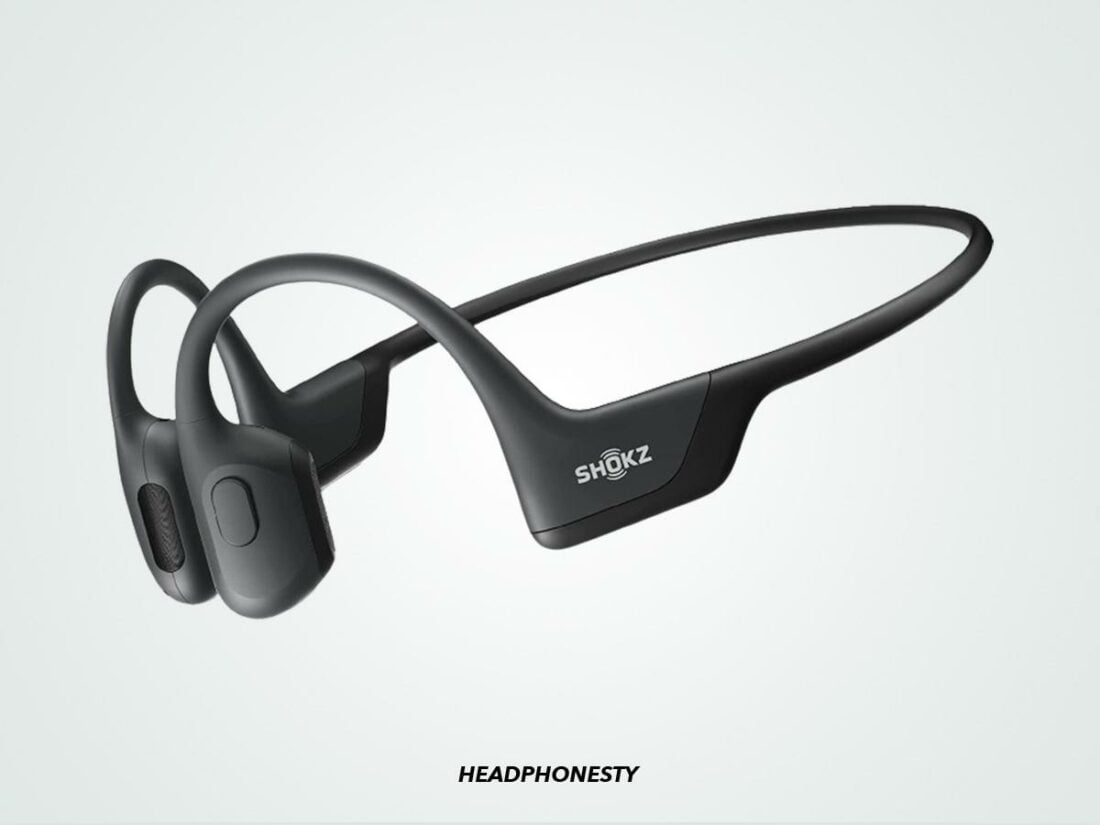
Key features
- Type: Bone conduction headphones
- Connectivity: Wireless
- Battery life: 10 hours
- Max output volume: 90 dB
- Additional features: Standard & vocal hearing modes, Shokz companion app
The Shokz OpenRun Pro are our top pick for the best headphones for the hearing impaired due to their form factor and listening experience. With these, those with hearing loss can still listen to decent audio quality that won’t interfere with their hearing aids.
These headphones sit just in front of your ears, leaving enough space to wear most hearing aids without any interference. So, you won’t have to pick between listening to your music or keeping your hearing aid on.
There are two hearing modes you can use: standard and vocal mode.
The standard mode treats all sound frequencies equally – which is great for when you want to focus on your music.
On the other hand, the vocal mode enhances the mid-range, where the human voice often falls into. This preset can work for movies, voice-centered audio, or even conversations when using the OpenRun Pro as a PSAP.
Shokz also partnered with the Petralex app, an app that turns your headphones into hearing aid alternatives. The Petralex app will use the microphones in the Shokz OpenRun to pick up noises around you and relay them as sounds through the headphones.
The OpenRun Pro are also IP65 certified, meaning they’re water and dust-resistant. So you don’t have to worry about them when working out or going outdoors. You’d also get a slim carrying case for when you’re taking them traveling.
While they’re overall excellent headphones, the Shokz OpenRun Pro aren’t really meant to be used at max volume. There’s a noticeable vibration at max volume, which can cause your cheekbones to feel numb after a while.
Sound World Solutions CS50+
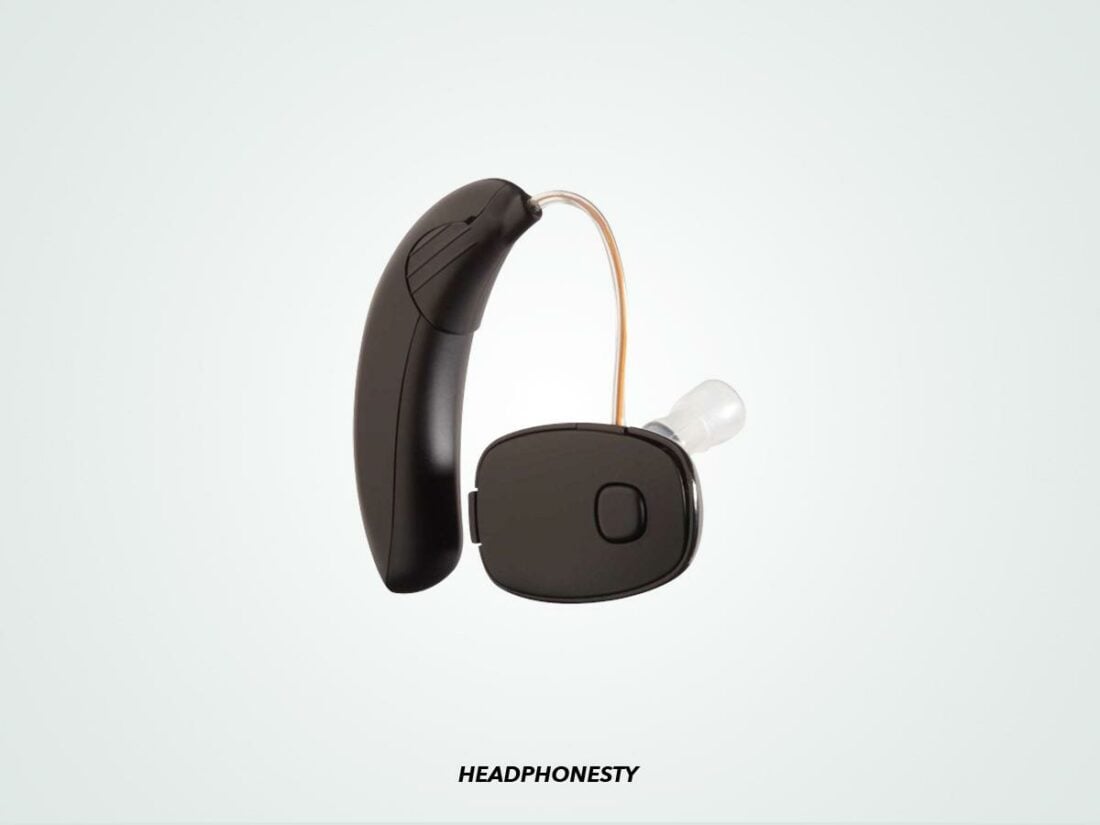
Key features
- Type: True wireless in-ear with ear-hook
- Connectivity: Bluetooth
- Battery life: 15 hours
- Max gain: 25 dB
- Max output volume: 112 dB
- Additional features: Frequency adjustment
The CS50+ are a pair of PSAPs that offer granular control for those with difficulties hearing the different types of sounds. Not only that, the CS50+ also have a lightweight design, comfortable fit, and a handful of other high-impact features for the hearing impaired.
The CS50+ are designed with hearing loss in mind. With the CS Customizer app, you can control which frequencies to enhance or choose from the three preset modes, depending on your preferences:
- Everyday mode – this is based on your personalized sound profile, resulting from a hearing test inside the app.
- Restaurant mode – picks up sounds from those in front of you and isolates them from a relatively noisy environment to aid in conversations.
- Entertainment mode – this mode increases low-frequency sounds, which is great for attending concerts, musicals, etc.
You can also create custom presets by adjusting the volume, treble, mid, and bass volume settings on both earbuds or individually.
For example, you can increase the treble frequencies if you want to focus on voices. This helps reduce feedback and improve clarity, relying less on presets to find the perfect balance.
The CS50+ also come with Bluetooth 4.2, meaning they can work as regular earbuds you can use with your phones or laptops. However, they only use SBC codec, the lowest quality codec – so don’t expect studio-level audio experience.
Relaxmm Hearing Aids With Bluetooth
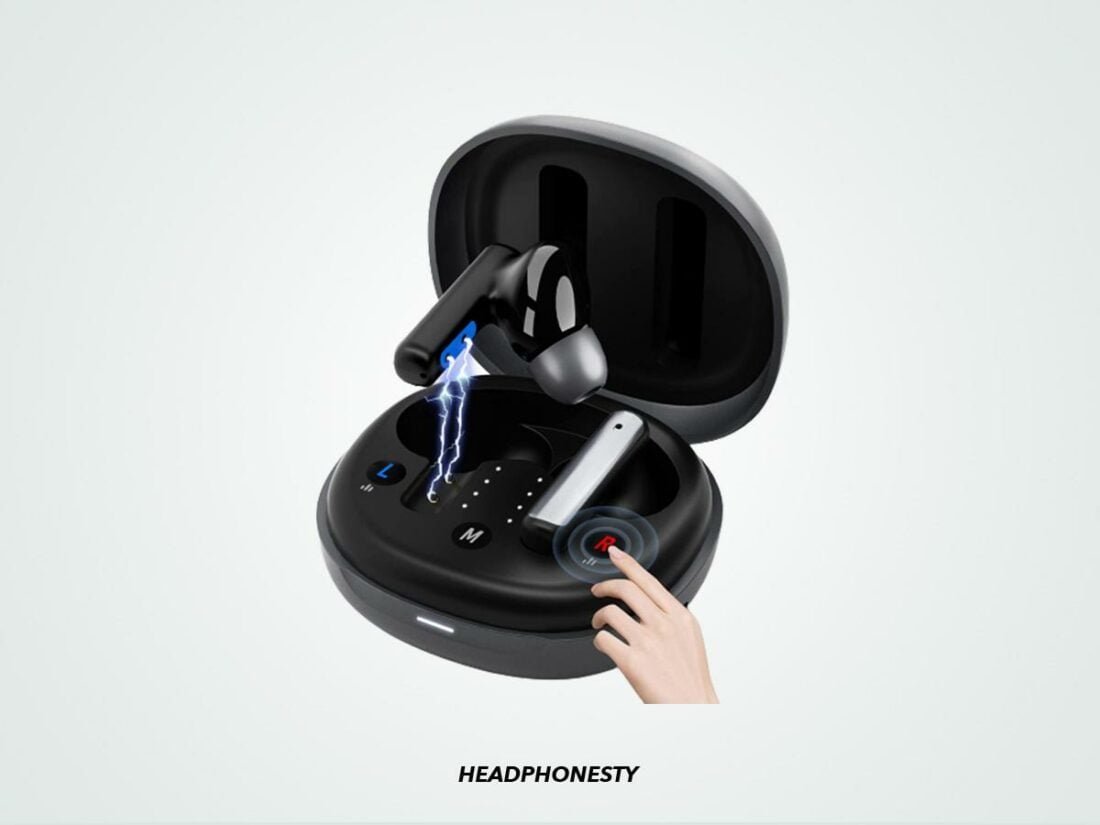
Key features
- Type: True wireless in-ear
- Connectivity: Bluetooth
- Battery life: 7 hours
- Max gain: 35 dB
- Max output volume: 112 dB
- Additional features: Frequency adjustment
If you like the Sound World CS50+ but have a tighter budget at hand, the Relaxmm Hearing Aids with Bluetooth can be a viable alternative for a fragment of the cost.
Like the CS50+, these PSAPs come with four amplification modes: normal, outdoor, TV, and conversation. You can switch between hearing modes by either pressing the button on the charging case or double-tapping the sensors on the earbuds.
With a max volume of up to 112 dB, the Relaxmm Hearing Aids get plenty loud. This is loud enough to help with most cases of mild to moderate hearing loss.
The earbuds can also remember the volume and hearing mode when they were last used. So you won’t be caught off-guard with louder or quieter settings since everything will be as you set it up.
The Relaxmm Hearing Aids also have active noise reduction, which will help to suppress the ambient sounds that may interfere with your hearing.
Finally, the Relaxmm use Bluetooth 5.2, meaning you can use them as a pair of true wireless earbuds with your phone or laptop. However, you can’t use the amplification and Bluetooth simultaneously. Connecting the PSAPs to your device via Bluetooth will turn them into regular earbuds – no amplification.
Nuraphone
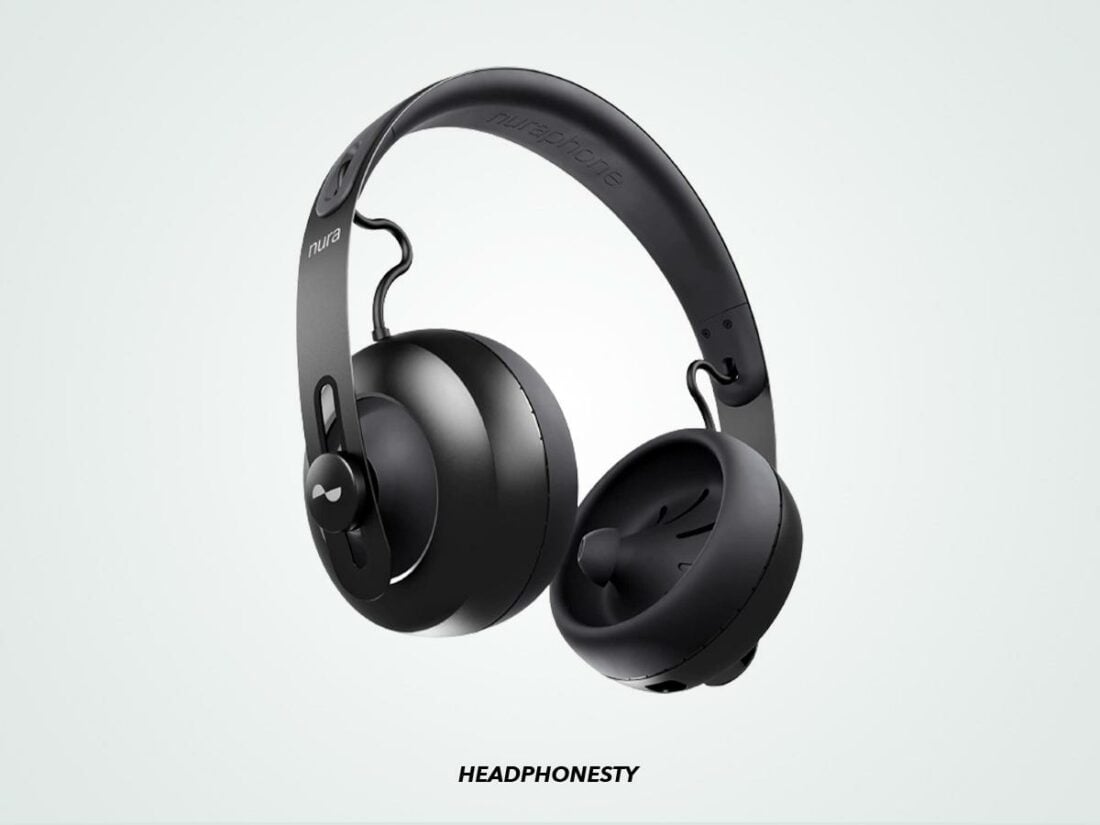
Key features
- Type: Over-ear, in-ear
- Connectivity: 3.5mm wire or Bluetooth
- Battery life: Up to 20 hours
- Max output volume: 120dB
- Additional features: Automatic personalized tuning, Active Noise cancellation
Claiming to be the world’s smartest headphones, the Nuraphone headphones are rich with features to match your unbalanced hearing.
When paired with the free Nura app on Apple or Android, the headphones can automatically create a hearing profile that’s tailored to your hearing loss in under a minute.
The Nuraphone also come with a decent ANC and natural-sounding Social Mode. The Social Mode slightly lowers the music volume and feeds in ambient noises around you, which helps greatly when you want to listen to conversations.
Yet, the Nuraphone have more up their sleeves than just the personalized sound, ANC, and social mode. You’ll also get immersion mode – a form of bass-boosting EQ, and up to 20 hours of playback time.
Nuraphone’s unique design uses both in-ear and over-ear form factors, providing double noise isolation. However, this may cause comfort issues – especially with prolonged use. This also means that despite the over-ear design, you won’t get to wear hearing aids underneath the ear cup.
XDU Pathfinder
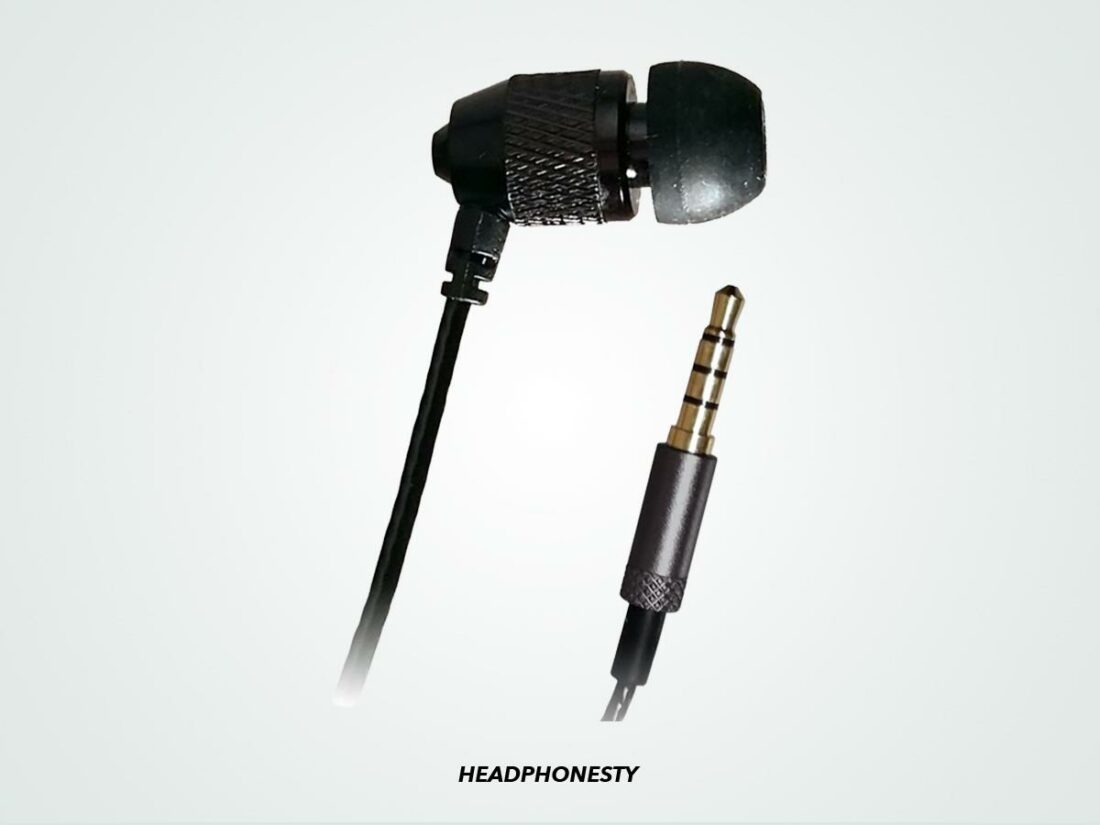
Key features
- Type: Monaural in-ear
- Connectivity: Wired
- Additional features: Stereo-to-Mono conversion
The XDU Pathfinder single in-ear headphone is designed to deliver converted stereo-to-mono audio through a durable nylon-reinforced TPU cable, allowing you to hear everything through its one driver.
So, if you’re deaf in one ear, or are only hard of hearing in one ear, this single earpiece will work great as it automatically converts all audio to one channel. This means the headphone will treat all sounds as if they were all coming from one source.
You can wear this earbud in either the left or right ear. And, you can customize the fit by easily replacing the soft rubber ear tip with one of the different size options for increased comfort. It works with any device that uses a 1/8 inch or 35mm plug.
The 42-inch cable may be a welcome inclusion for those using them with devices they need to sit away from; however, for everyday use, managing the cable can be quite a hassle. This becomes worse due to the kinks in the cable caused by how the cord is packaged.
Sony WH-1000XM5
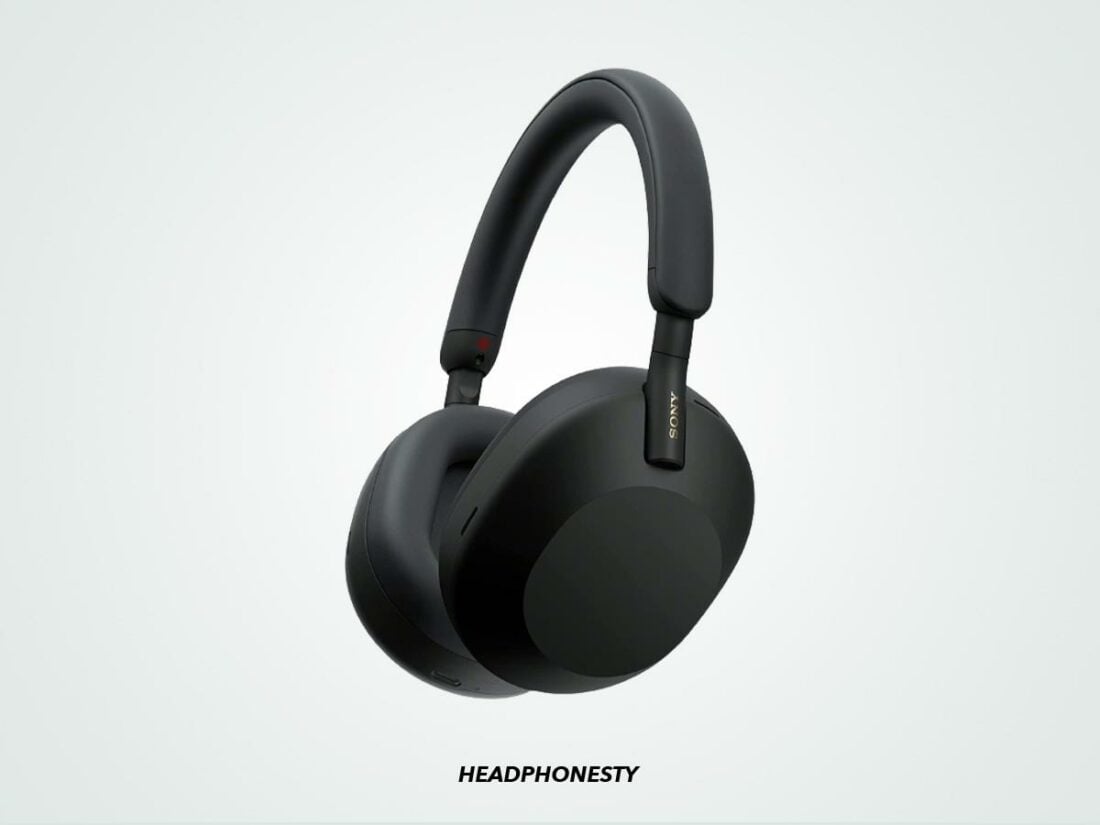
Key features
- Type: Over-ear headphones
- Connectivity: Bluetooth
- Battery life: 30 hours
- Max output volume: 105dB
- Additional features: Frequency adjustment, ANC, transparency mode, conversation mode
The Sony WH-1000XM5 offer a combination of roomy leatherette ear cups with plushy padding to minimize pressure on your ears – even with hearing aids on. Combine that with the excellent ANC and transparency mode, and the WH-1000XM5 are an ideal pair to wear with your hearing aids.
The ANC on the WH-1000XM5 can help reduce ambient noise that may interfere with your audio. You won’t have to crank up the volume as much to hear your music clearly.
But if you feel like hearing the world around you, the WH-1000XM5 have superb transparency mode for that. There’s also a convenient feature that activates transparency mode temporarily by cupping your hand over the right ear cup.
Another feature that makes the WH-1000XM5 stand out is the conversation mode. In this mode, the headphones will seamlessly switch from ANC to transparency mode when they detect your voice.
The Sony Headphones Connect app also grants you granular control of the ANC, transparency, and conversation modes. The app also lets you customize hearing modes, toggle wearing detection, switch the guidance language, and access a plethora of other customizations.
If sound quality is a concern for you, the WH-1000XM5 play audio via Bluetooth with the LDAC codec. Any test tracks we threw to these headphones sound crisp and rich with details with minimum sibilance, even at max volume.
Although the WH-1000XM5 are an excellent all-around pick to wear alongside your hearing aids, they’re not exactly the most budget-friendly option. Furthermore, there’s no official IP rating for these headphones.
TV Ears Digital Wireless Headset System
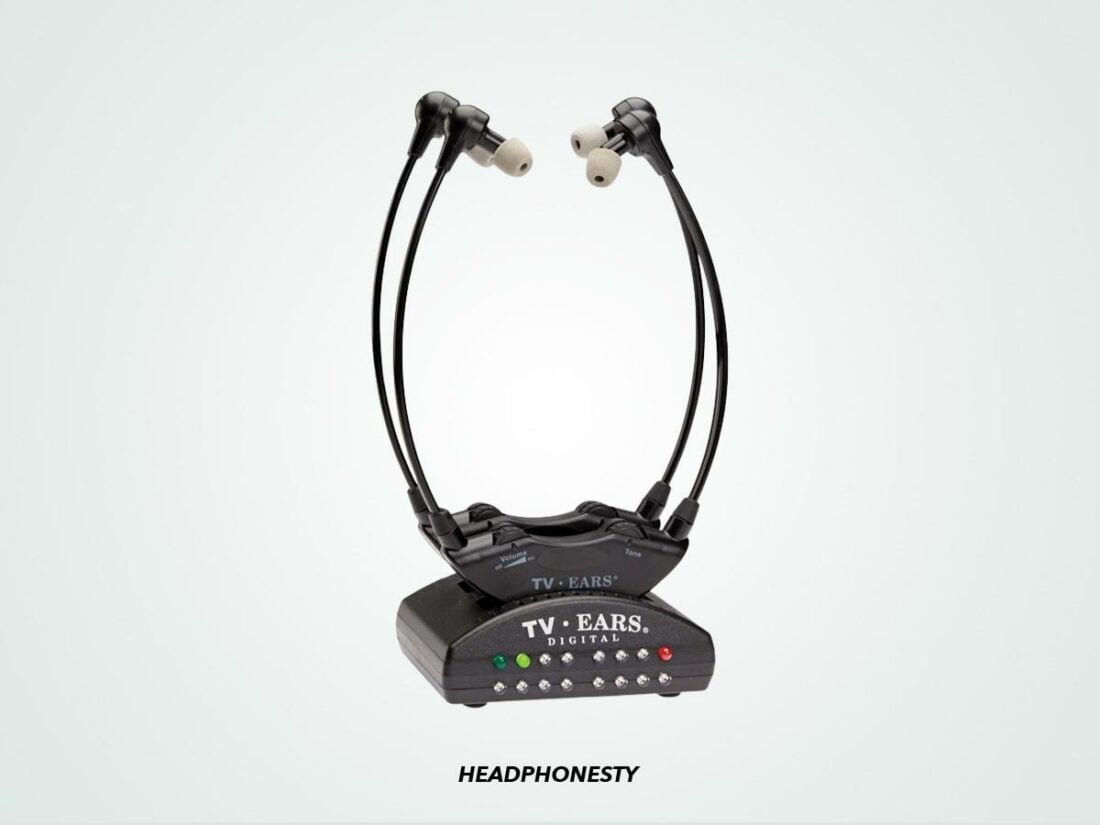
Key features
- Type: In-ear
- Connectivity: IF & Analog & digital TV connection
- Battery life: 4-6 hours
- Max output volume: 120dB
- Additional features: Proprietary Voice Clarifying Circuitry
The TV Ears Digital Wireless Headset System is a device designed especially for watching television.
If you or someone you know has difficulties hearing conversations or speech on your TV, these are a must-have product.
The voice clarifying feature is helpful for everyone who struggles with hearing dialogues. But it’s even more so for people with Presbycusis (age-related hearing loss), which mainly affects the ability to hear high-pitched sounds.
They also go as loud as 120dB, which is quite loud even for people with moderate hearing loss – though we don’t recommend going that loud all the time.
Unlike most headsets that go behind or over your head, the TV Ears hang in front of your neck. This is because the headsets use infrared connectivity, which requires them to be in line of sight with the adapter.
These headsets mostly sound excellent for their intended purpose. But conversation-heavy content, like interviews and podcasts, can get fatiguing after a while.
AirPods Pro
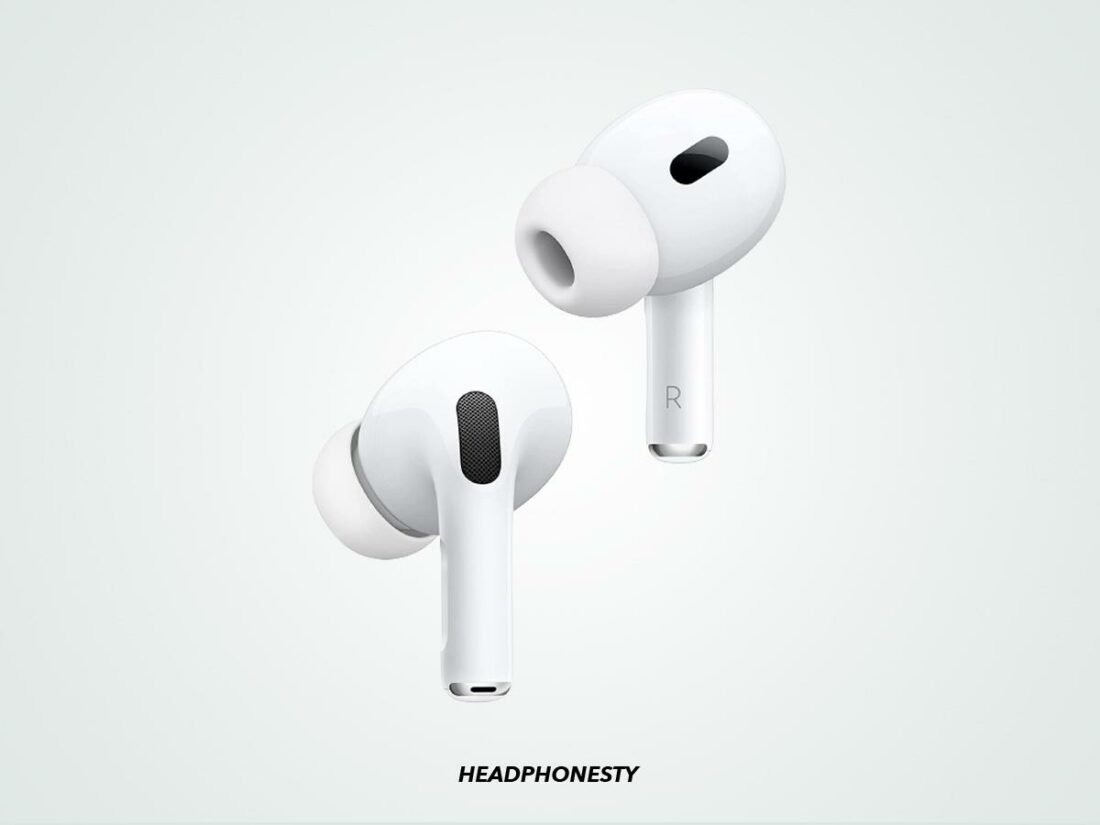
Key features
- Type: True wireless in-ear
- Connectivity: Bluetooth
- Battery life: 4.5 hours
- Max output volume: 102dB
- Additional features: Active Noise Cancellation, Transparency Mode, Live Listen, Customizable Hearing Profiles
The AirPods Pro offer various transparency and ANC modes. The collection of such features can also help those with mild hearing loss to have conversations without having others raise their voice.
Aside from the typical ANC and transparency mode, AirPods’ smart ANC can also turn itself on to protect your hearing when it detects loud noises like a passing ambulance or siren. This lets you have transparency mode active without worrying about further hearing loss due to unexpected sounds.
Plus, if you use devices with iOS 12.0 or later, you also get the Live Listen feature.
The Live Listen feature uses your iOS device as a microphone to relay audio back to the AirPods. If you have difficulty listening to someone talking across the room, simply activate the Live Listen, place your iPhone or iPad closer to the source, and you’ll hear everything clearer with amplified volume.
Thanks to their small form factor and charging case, you can take them wherever you go. The AirPods Pro have an IPX4 rating, making them sweat and water-resistant, so you don’t have to fret over them coming into slight contact with water.
Often seen as regular earbuds, the AirPods Pro – with enough tweaking – can be an assistive hearing aid for those with mild hearing loss. However, their steep pricing may hinder some people from getting the AirPods Pro.

How about covering corded headphones that don’t take batteries?
Hi Douglas! Thank you for voicing your concern. We’ve edited the article for clarity. 🙂 As of now, only XDU Pathfinder and Nuraphones can work in wired mode.
The Lucid Audio AMPED headphones also have a wired option but only for connecting to the audio source. They still need batteries for sound amplification.
Unfortunately, there are currently no sound-amplifying headphones that can work without batteries that we know of. If you have any suggestions, feel free to let us know and we’ll check it out!
In ear one ear only, cordless options would be helpful. Ear buds batteries don’t last long enough for a work day.
My wife got me a some avantree ht5150 headphones. They’re great when you plug in the audio cable but that turns off the sound 🔈 for everyone else. I’m deaf in my left ear with constant ringing 24/7. I’m used to it now😊. But for some reason I get this nagging feeling she bought the wrong set of headphones.🤔.
My father is wearing cool looking glasses and wants to look cool.
All these super expensive hearing aid that want to camouflage they are not there, are a mess: when he puts on/off his glasses they fall on the forest floor, never to be found back.
He needs a bluetooth headset that dangles around his neck, like these magnetic clip reading glasses and he can quick & easily put on when he wants to listen to something or somebody.
I think the solution 1 in the article is what he needs.
How can he try it out? Just order them and try them for a week and eventually send them back?
Thy
Unless she likes them then he won’t have to send them back
I get constant ear infections and I have lost 70% of my hearing due to a degenerative condition that had to be resolved with surgery, so I have to use Bluetooth headphones but some things like dvd players and Xbox controllers don’t use Bluetooth so could you recommend some wired headphones that are very loud please?
I’ve just taken up gliding as a hobby and looking for the best lightweight headset solution for the hard of hearing in order to follow instructions from the backseat instructor. Would a bone conductor system be the best option.
I’m looking for wired earbuds that will work for my father who’s blinds and very hard of hearing. They have to be wired and simple/easy since he’s blind and loud since he’s hard of hearing.